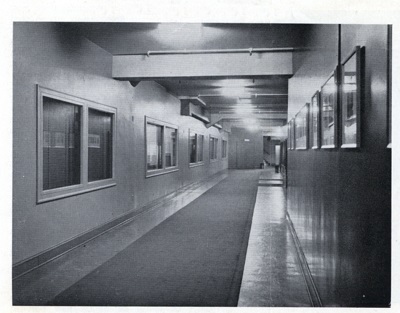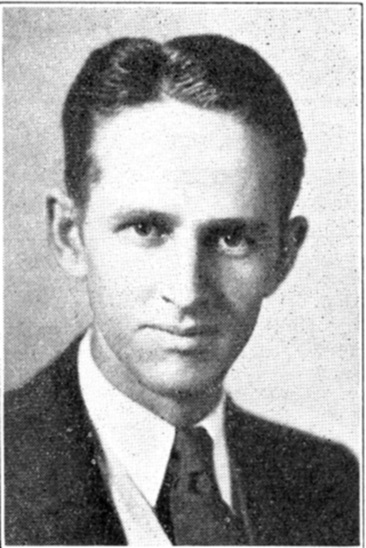Radio Articles
The Voice Of St. Louis [A Flooring Perspective]
By M.J. Conohan
The “Voice of St. Louis” is the powerful 50,000 watt radio station KMOX. One of the strongest and most popular radio stations in the middle west, KMOX has a listening audience over a radius of 1,000 miles. A member station in the Columbia Broadcasting System, it brings national broadcasts to its listeners as well as rendering all the radio services of regional interest to the people in the St. Louis business and agricultural area.
KMOX is located in the Mart Building in downtown St. Louis, KMOX being the only business enterprise that remained in the building when the government took over the property several years ago for use as an Army Medical Depot. The offices and studios of the station are located on the second floor of the building and occupy approximately 22,000 square feet of floor space. The transmitter for KMOX is located several miles outside the city limits of St. Louis.
Only a small portion of the space occupied in the Mart Building by the radio station is devoted to the actual broadcasting of programs. Long hours of preparations are required to obtain the perfection and split [second] timing so necessary in radio work and consequently much space is used for offices devoted to the development and preparation of programs. The business offices of the station are also located in the Mart Building.
 The floors of radio station KMOX are all covered with serviceable floor coverings: rubber tile, asphalt tile, rubber and linoleum. The KMOX Playhouse has carpeting in the area used for the seating of audiences and the center portion of the main corridor is carpeted. Mr. L.C. Burrows, Maintenance Engineer for KMOX, has a crew of five men under the supervision of Mr. J.L. Scherder who takes excellent care of the floor services.
The floors of radio station KMOX are all covered with serviceable floor coverings: rubber tile, asphalt tile, rubber and linoleum. The KMOX Playhouse has carpeting in the area used for the seating of audiences and the center portion of the main corridor is carpeted. Mr. L.C. Burrows, Maintenance Engineer for KMOX, has a crew of five men under the supervision of Mr. J.L. Scherder who takes excellent care of the floor services.
There are six studios, designated as studios A, B, C, D, E and F. Each studio has a Master Control Room, with a glass partition facing the studio so the engineer present for each broadcast can see exactly how the program is proceeding in the studio. The engineer has full charge of the broadcast, advising the various performers by hand signals when to begin their parts and when to interrupt the program for commercials. Each control room has a recording device to make recordings of the broadcasts and this equipment is used in playing or recordings or transcriptions for broadcast. There is a special room called the Recording Room which is used in making transcriptions for future broadcast.
Double doors lead to the various studios to provide a sound “trap” when it is necessary for someone to enter the studio during a broadcast. Some of these doors are heavily soundproofed and weigh as much as seven hundred pounds. All the studios are open to view, three panes of glass with air spaces between the panes and set on felt pads making the studio soundproof. The interiors of the studios are all acoustically engineered to make for good tonal quality in the broadcasts. One studio required considerable engineering: the ceiling and walls are all paneled with acoustical board, the board being set on the surfaces in a zig-zag pattern rather than flat against the wall surface so that sound waves are broken up and do not “bounce back” into the microphone; in addition the floor is set on springs six to eight inches high as a further assurance of proper sound quality.
The KMOX News Room is serviced by four teletype machines with complete Associated Press news service. The studio used for news broadcasts at one time was a part of the news room but it has now been separated from the news room and soundproofed. One of the music studios contains a four bank organ, the pipes of which are set into the walls of the studio. There are also two grand pianos in this studio.
All the studios in KMOX with the exception of the Playhouse and the Magic Kitchen are covered with the same type of floor covering – rubber tile. The selection of this type of flooring was apparently made after considerable attention to serviceability and beauty. Alternate blocks of rubber tile in red and buff, black and yellow mottled or marbleized, light green and dark green, all with black borders, make the studios very attractive and the condition of the floors shows that they have proved to be very serviceable.
The news room and the news studio have the best floors in the studios. These rubber tile floors have been in service for twelve years and still show no wear. The floor of studio D is in two shades of green rubber tile and has always been difficult to clean properly. During the cleaning of this floor, it must be kept wet until all cleaning is completed to avoid streaking of the floor.
The stage of the KMOX Playhouse has three tiers, the floor of gray rubber and the risers of the tiers in blue. Every Saturday the Playhouse is host to eight hundred guests for two very popular programs.
It is interesting to know that the broadcasting of programs concerning the preparation of foods is done from real kitchens maintained by the larger studios. The KMOX Magic Kitchen is a complete kitchen that would delight any housewife. The deep red or maroon linoleum in the Magic Kitchen make[s] it very attractive.
Passageways, corridors and toilet rooms are floored with asphalt tile in brown, gray or black. Offices are covered with rubber tile except for a few of the executive offices which are carpeted.
Mr. Scherder finds that the floors do not require an undue amount of care, and maintenance at irregular intervals, as the floors require, has proved satisfactory. The floors are dry mopped daily to keep them clean. When additional maintenance is indicated, the floors are cleaned with a wet mop and neutral soap. All but the Magic Kitchen are then treated with Finish Material and buffed. Some of the floor areas can be kept in good condition for as long as two months at a time with daily dry mopping.
Due to the nature of the linoleum floor in the Magic Kitchen, a “spewing” of oil apparently coming from the porous surface of the linoleum, it does not readily take applications of wax. It has been found that the cleanest and neatest looking floor for this surface can be obtained by merely scrubbing it with neutral soap and water and leaving it untreated.
Even the experienced radio announcer is subject to “mike fright” when facing his unseen audience. Two black smudges on the floor of one studio just before the microphone proved to be due to the nervous scraping of the feet of an announcer. Due to the methods of maintenance used in KMOX these “burns” are easily removed and do not injure the floor.
The selection of proper maintenance materials and good maintenance methods for the floors of KMOX studios has materially aided in making the appearance of the studios fit in with the top quality of its programs.
(Originally published in Floorcraft magazine 12/1943 ).
 I couldn’t help but reflect what a lot of pleasure such an open air place gave young people who were swaying and whirling around in floor in an inspired manner. It was cool, gaily lighted and the music impelling. I had a severe case of the “jitters” when Billy Langinvited me up to the microphone to announce a few of the numbers and couldn’t help envying him his easy manner and infectious smile as he greeted his friends both on the floor and over the air. There is a stir of anticipation when the Old Night Watchman enters each place and it is easy to see what an addition he is to the spirit of revelry.
I couldn’t help but reflect what a lot of pleasure such an open air place gave young people who were swaying and whirling around in floor in an inspired manner. It was cool, gaily lighted and the music impelling. I had a severe case of the “jitters” when Billy Langinvited me up to the microphone to announce a few of the numbers and couldn’t help envying him his easy manner and infectious smile as he greeted his friends both on the floor and over the air. There is a stir of anticipation when the Old Night Watchman enters each place and it is easy to see what an addition he is to the spirit of revelry. Versatility – one of the first requisites of a radio station attaché – is shown in the remarkable combination of talents of Don Hunt, chief continuity writer at KMOX, who now makes his debut as “The KMOX Song Writer.” He is now featured over KMOX each Friday at 10:05 a.m.
Versatility – one of the first requisites of a radio station attaché – is shown in the remarkable combination of talents of Don Hunt, chief continuity writer at KMOX, who now makes his debut as “The KMOX Song Writer.” He is now featured over KMOX each Friday at 10:05 a.m. William H. West, who resigned last week as Director of Operations of KMOX, has become General Manager of station KSD. The station is undergoing a period of expansion and reorganization and Mr. West is in charge of all operations.
William H. West, who resigned last week as Director of Operations of KMOX, has become General Manager of station KSD. The station is undergoing a period of expansion and reorganization and Mr. West is in charge of all operations.